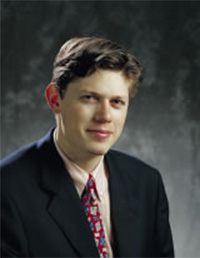Seminars
Thu |
RF Performance of Fiber-Optic LinksDr. Edward Ackerman, Photonic Systems, Inc., Billerica, MA | |
|
Abstract: To take advantage of the extremely low-loss and low-dispersion characteristics of single-mode optical fiber requires prudent selection and optimization of components that generate and modulate the light at one end of the fiber and detect it at the other end, resulting in what’s conventionally called a fiber-optic link. To retrieve RF signals from radar and communications antennas, fiber-optic links must meet especially stringent performance requirements. Compared to conventional RF transmission technologies, fiber-optic links can impart many advantages, including smaller size, lighter weight, lower attenuation over longer distances, and improved EMI immunity. The advantages conferred by RF fiber-optic links have often been overshadowed, however, by insufficient signal-to-noise performance. Recently there have been dramatic improvements in the RF performance, particularly the gain and noise figure, of fiber-optic links that have made them compare more favorably with other RF technologies. In this presentation we review the state of the art in RF fiber-optic links, and highlight some of the recent and significant developments in this area. Biography: Edward I. Ackerman received his B.S. degree in electrical engineering from Lafayette College in 1987 and his M.S. and Ph.D. degrees in electrical engineering from Drexel University in 1989 and 1994, respectively. From 1989 through 1994 he was employed as a microwave photonics engineer at Martin Marietta’s Electronics Laboratory in Syracuse, New York, where he used low-loss narrowband impedance matching techniques to demonstrate the first amplifierless direct modulat! ion analog optical link with RF gain (+3.7 dB at 900 MHz). From 1995 to July 1999 he was a member of the Technical Staff at MIT Lincoln Laboratory, where he developed high-performance analog photonic links for microwave communications and antenna remoting applications. During this time he achieved the lowest noise figure ever demonstrated for an amplifierless analog optical link (2.5 dB at 130 MHz). While at Lincoln Laboratory he also developed and patented a novel linearization technique that uses a standard lithium niobate modulator with only one electrode to enable improved analog optical link dynamic range across broad bandwidths and at higher frequencies than other linearization techniques currently allow. Currently he is Vice President of R & D for Photonic Systems, Inc. of Billerica, Massachusetts. He has co-edited a book and has authored or co-authored three book chapters as well as more than seventy technical papers on the subject of analog photonic subsystem performance modeling and optimization. In recognition of these achievements, he was recently elected a Fellow of the IEEE. Location: MIT Lincoln Laboratory |
